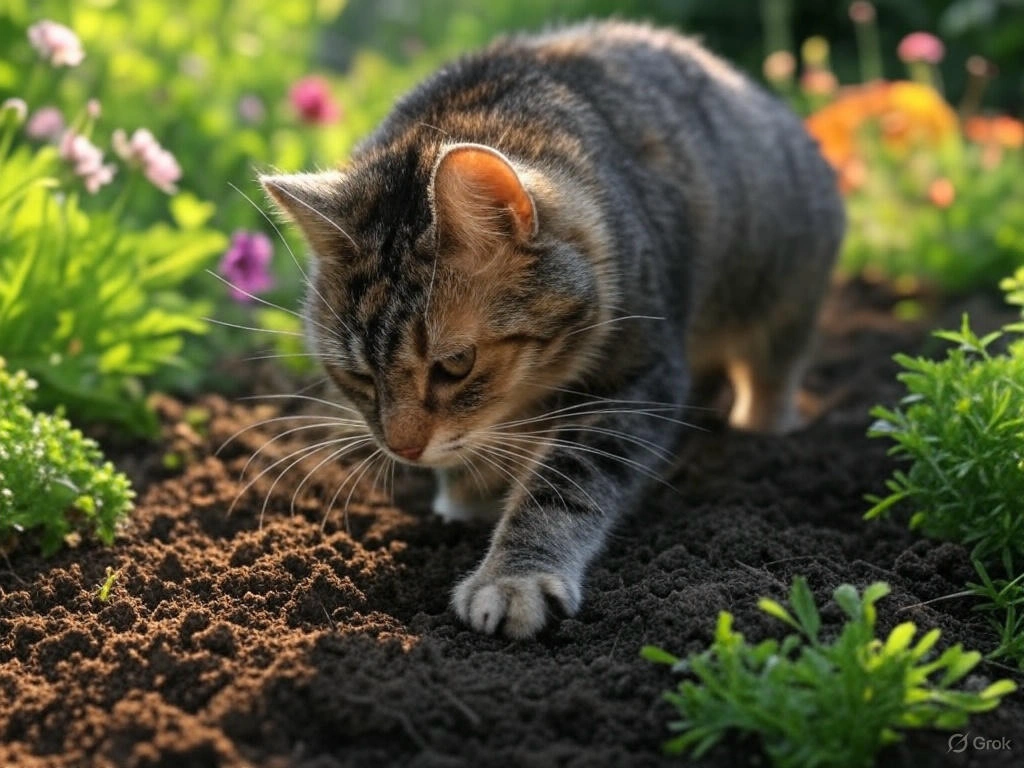How to Stop Cats from Digging in Your Garden: A Comprehensive Guide
Learn effective tips and humane solutions to stop cats from digging in your garden and protect your plants with this comprehensive guide.
If you’ve ever found your garden beds turned into a cat’s personal litter box, you know the frustration of dealing with feline digging. Cats are drawn to soft, loose soil, which they see as the perfect spot for burying waste or simply exploring. This behavior can damage your plants, spread diseases like toxoplasmosis, and leave your garden in disarray.
But don’t worry—there are plenty of humane and effective ways to keep cats out of your garden.
In this guide, we’ll explore a variety of strategies, from physical barriers to scent deterrents, backed by practical tips and reliable sources.
Key Takeaways
- Physical Barriers: Covering soil with mulch, rocks, or chicken wire can stop cats from digging.
- Scent Deterrents: Citrus peels, coffee grounds, or herbs like rue can repel cats with their strong smells.
- Scare Tactics: Motion-activated sprinklers and ultrasound devices are great for startling cats away.
- Combine Methods: Cats can adapt, so using multiple deterrents often works best.
Physical Barriers: Make Your Garden Less Inviting
One of the easiest ways to deter cats is to make your garden soil less accessible. By covering bare areas with materials that are tough or uncomfortable to dig in, you can protect your plants while keeping the garden functional.
- Mulch, Rocks, or Chicken Wire: Lay down coarse mulch, rocks, or chicken wire over the soil. These allow plants to grow through but block cats from digging. The David Suzuki Foundation suggests placing twigs 2 inches apart until spring plants take root, which also supports wild bees (Messy Yards Help Bees).
- Prickly Textures: Scatter pine cones, eggshells, or even repurpose plastic carpet runners (nub side up) to create a surface cats won’t enjoy walking on, as recommended by FixNation.
- Metal Edging or Trellises: Greneaux Gardens advises laying metal garden edging or wire trellises flat over the soil, especially in raised beds, to prevent digging.
- Taut String: For smaller flower beds, string taut lines around the area. Cats dislike climbing over or under such obstacles, making this a simple yet effective trick.
Here’s a quick reference table for physical barriers:
| Method | Details | Source |
|---|---|---|
| Mulch, rocks, wire | Coarse mulch, rocks, or chicken wire; plants grow through, blocks digging | Melinda Myers, David Suzuki Foundation, FixNation |
| Prickly materials | Pine cones, eggshells, or plastic mats (e.g., Cat Scat) | David Suzuki Foundation, FixNation |
| Metal edging or trellises | Lay flat over soil, prevents digging, great for raised beds | Greneaux Gardens |
| Taut string | String around flower beds to create an obstacle | Various gardening tips |
Scent Deterrents: Use Smells Cats Hate
Cats have sensitive noses, so leveraging scents they find unpleasant is a natural way to keep them at bay. These methods are easy to implement and often use household items.
- Citrus Peels: Scatter orange, lemon, or grapefruit peels around your garden. FixNation and Quora users note that cats tend to steer clear of these strong citrus smells.
- Coffee Grounds: Sprinkle used coffee grounds in your garden beds. Reddit discussions and FixNation highlight their effectiveness, likely due to the potent odor.
- Herbs: Plant rue, lavender, pennyroyal, or Coleus canina, as suggested by Melinda Myers and the David Suzuki Foundation. These not only repel cats but can also attract pollinators, boosting your garden’s ecosystem (Create Pollinator-Friendly Garden).
- Commercial Repellents: Products like Cat Stopper smell pleasant to humans but drive cats away, according to Melinda Myers.
- Chicken Manure: FixNation suggests spreading chicken manure, which doubles as a fertilizer, but apply it carefully to avoid over-fertilizing.
Tip: Cats may get used to a single scent over time, so rotate between citrus, coffee, or herbs for lasting results.
Scare Tactics: Startle Cats Away
For a more proactive approach, startling cats with sudden movements or sounds can discourage them from returning. These methods work well in larger gardens or for persistent visitors.
- Motion-Activated Sprinklers: Devices like Scarecrow or Spray Away release a burst of water when cats approach, as recommended by FixNation and the David Suzuki Foundation. Keep water usage in mind, especially in dry seasons.
- Ultrasound Devices: Products like Cat Stop emit high-frequency sounds that bother cats but are inaudible to humans, making them a discreet option for urban gardens.
- Noise Makers: Wind chimes, motion-sensitive bells, or jars filled with pebbles can create unexpected sounds that scare cats off, per the David Suzuki Foundation.
- Compressed Air: Melinda Myers suggests DIY solutions like motion-triggered air cans for a quick blast of air or noise to startle intruders.
Combining scare tactics with other methods can enhance their effectiveness, as cats may otherwise grow accustomed to a single deterrent.
Behavioral and Environmental Modifications
Sometimes, the best defense is redirecting cat behavior or addressing the root causes of their visits. These long-term solutions can create a cat-free garden while keeping things humane.
- Outdoor Litter Box: The David Suzuki Foundation proposes setting up a sandbox with catnip or mint to lure cats away from your vegetable beds. Clean it regularly to manage waste safely and avoid health risks.
- Don’t Feed Strays: Feeding stray cats can make your garden their territory, as warned by WM James & Co. (10 Tips on How to Keep Cats Out Of Your Garden). Resist the urge to leave food out.
- Talk to Neighbors: If the cats belong to neighbors, a friendly chat can go a long way. WikiHow Pet suggests asking them to keep their cats indoors at night or supervise them better.
- Build a Catio: For your own cats, consider a “catio” (outdoor enclosure) to give them a safe space without letting them roam your garden. This also protects wildlife, as roaming cats kill around 140 million birds annually, per the David Suzuki Foundation (Prevent Wildlife Injuries).
- Dedicated Digging Area: Offer a small sandbox for cats to dig in, as suggested by Talking of Plants (How to Deter Cats from Digging in Your Flower Beds). This can redirect their instincts away from your flower beds.
Other Clever Tricks
A few additional strategies can round out your cat-proofing plan, adding extra layers of protection.
- Fake Snakes: Place rubber wriggly snakes at the base of plants, as FixNation suggests, to tap into cats’ natural fear of snakes.
- Wash Away Scents: Use water or eco-friendly castile soap to remove cat urine or other attractants, reducing repeat visits, per the David Suzuki Foundation (How to Use Castile Soap).
- Predator Urine Repellents: Commercial products like Shake-Away or Renardine mimic predator urine, but FixNation advises checking they’re non-toxic and effective before use (The Spruce – Cat Repellents).
Practical Tips for Success
Cats are clever and can adapt to single deterrents, so a multi-pronged approach is often the most effective. For example, combine chicken wire barriers with citrus peels for a one-two punch. Freshly turned soil is like a magnet for cats, so cover these areas with netting or mulch right away to prevent digging from starting. If you’re dealing with feral cats, reach out to a local animal shelter for support, as advised by the David Suzuki Foundation.
It’s also worth aligning your cat-proofing with other gardening goals, like creating a pollinator-friendly space (Gardening Tips for Beginners). Recent advice from the RSPCA and Cats Protection stresses humane methods, noting that cats have a legal right to roam, and harmful deterrents could lead to trouble (RSPCA – How To Keep Cats Out Of Your Garden, Cats Protection – Keeping Cats Out of Your Garden). If new cats move into the neighborhood, switch up your tactics to keep them guessing, as The Spruce recommends.
With options ranging from low-cost solutions like pine cones and citrus peels to high-tech gadgets like motion sprinklers, there’s a cat-deterrent strategy for every gardener. By experimenting with these methods, you can find the perfect mix to protect your plants, keep your garden thriving, and ensure cats find somewhere else to roam—all while staying kind to our feline friends and the environment.


